
Churches - Bevendean History Project

St Wilfrid Church, Elm Grove, BrightonThe roads around
Elm Grove were laid out in the 1850s with residential development
occurring in two stages: during the 1860s, and then in the 1880s.
Tightly packed terraced housing was provided on the northern and southern slopes of the hill between the 1860s and 1900, and the area became very densely populated.
To begin with Anglican services were held in a series of rented rooms and halls in the area. As the congregation grew a temporary church built of tin was constructed on the site of the present church, at the junction of Elm Grove and Whippingham Road.
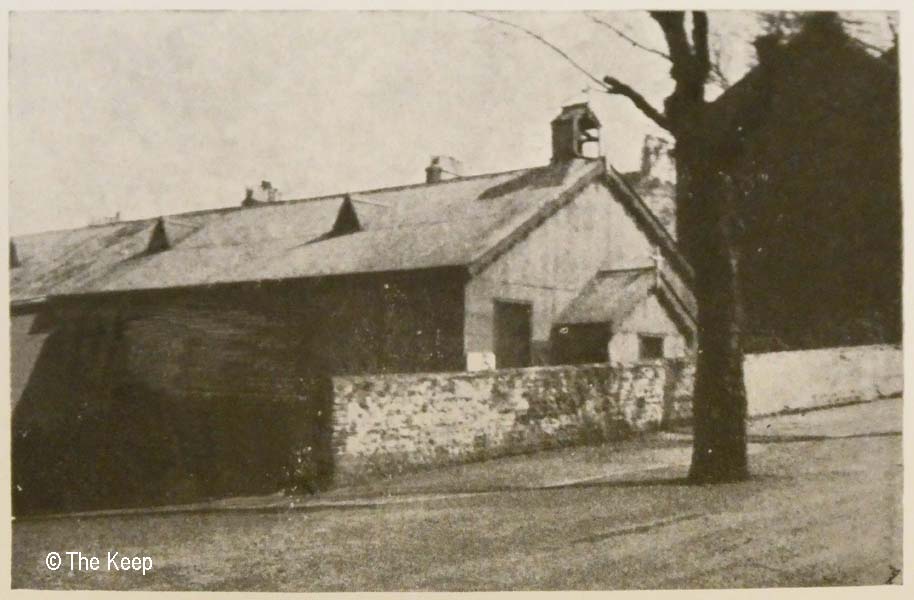
The Iron Church viewed from Elm Grove. Keep Ref: BHBox7/51
The iron church was inaugurated on 25 August 1901. A year earlier, the area had been designated a district within the Parish of Brighton. The building plans are dated 20 June 1901 and the service registers begin in 1901.
The church was dedicated in 1902 by the Bishop of Chichester Ernest Wilberforce.
By 1915 St Wilfrid's was listed as a chapel of ease to the parish church of St Peter.
The district of St Wilfrid was created from the parish of Brighton St Luke by an Order in Council of 21 April 1922. This brought an extra 2,000 people within its parish boundaries, and a permanent church was required.
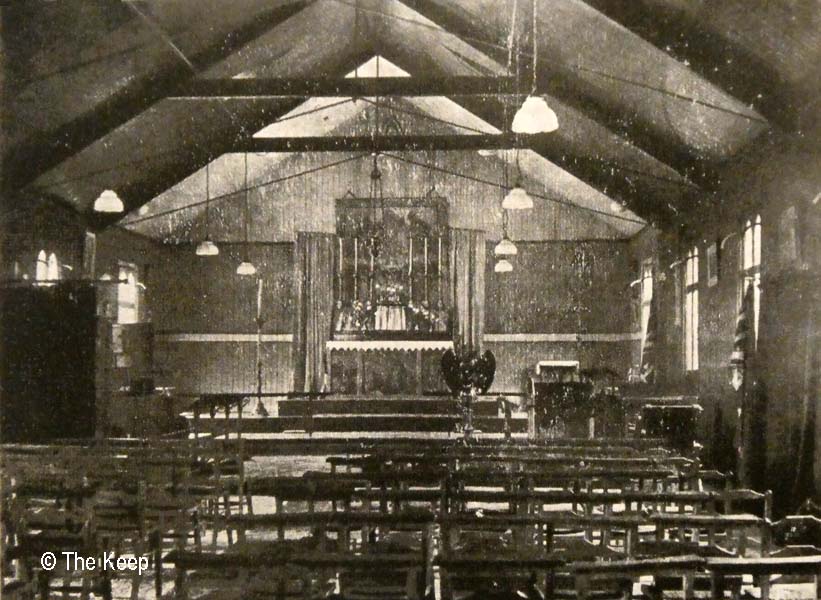
Interior of the St Wilfrid’s Church. Keep Ref: BHBox7/51
The tin church was enlarged in 1904-05 when a two-storey extension was built at the northern end of the building. The original building is darker than the extension on the plans.
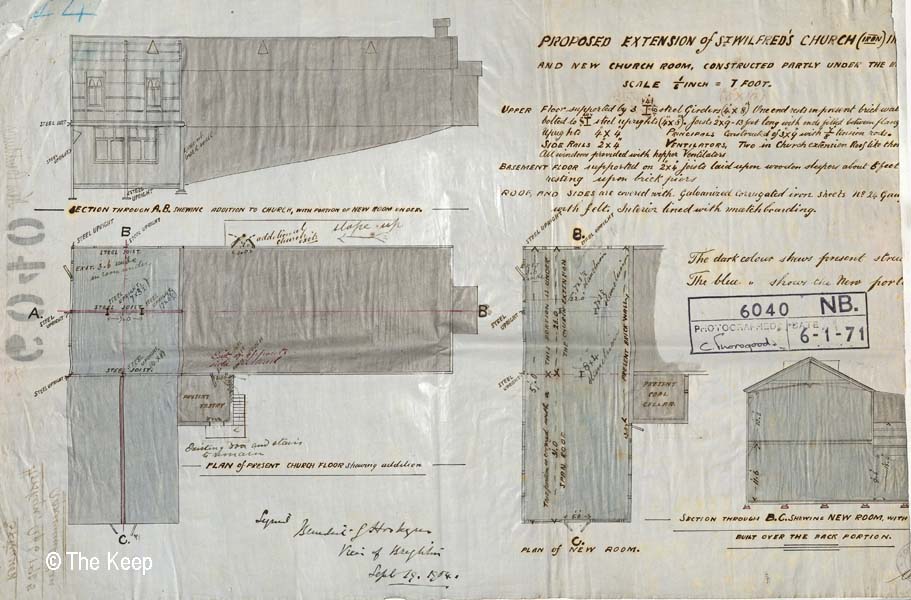
Keep Plan Ref: DB/D/7/6040
In the Brighton and Hove Herald in October 1932 the church was described as “The Cabbage Patch Church” or the “The Tin Kettle Church” quaint names given to St. Wilfrid’s church, Elm Grove, at a bazaar opened in the Mission Room to raise funds for a new church.
The Dean of Chichester opened the Bazaar and made the following observations.
“Both names were relevant for the people of St. Wilfrid, as they had a tin church in what was once a policeman’s cabbage patch.”
“The plot of land was bought 30 years ago with money from the Diocesan Bishops Fund.”
The Dean of Chichester was the Vicar of Brighton at the time and let the land for the magnificent sum of 30 shillings a year or so to a policeman, who made a very fine market garden out of it.
The Dean continued, “When the trams came up Elm Grove and the people of Brighton found that they could get up the hill for a penny they began to live up there. This was when the present tin church was put up and planning a permanent church has taken too long.”
“This place is the scandal of the Diocese, because there are 10,000 people here, and this is all they have to worship in. There is no other place with such spiritual destitution throughout the length and breadth of the County.”
Until 1922, St. Wilfrid’s was under the care of such devoted priests -in-charge as the Rev. C. H. Martin, now Rector of Blendworth, Hants; The Rev. T. J. James, now Prebendary of Heathfield and Vicar of Anne’s, Brighton; and the Rev. P. H. Pemberton, who became the first Vicar when the district became an independent parish in 1922.
On Mr Pemberton’s preferment to the Vicarage of All Souls’, Hastings, he was succeeded by the present Vicar (the Rev. W. A. E. Westall) whose energetic and self-sacrificing labours explain much of the “liveness” which characterises the Church life of the parish today”.
By 1932, £15,000 had been raised by the parishioners and from other sources, and services were held in the nearby parish hall (built in 1927) while the new church was built after the demolition of the tin church.
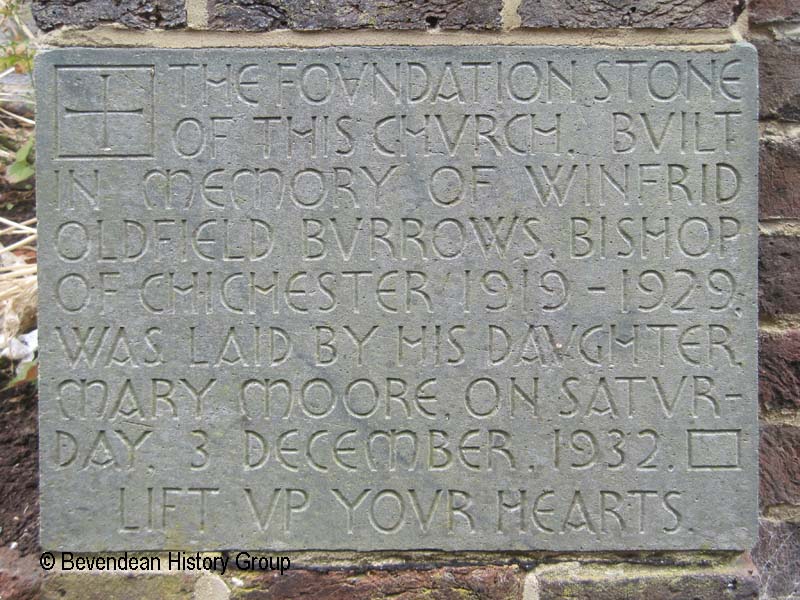
The foundation stone for the new church was laid on 3 December 1932 by Mary Moore the daughter of Bishop Winfrid Oldfield Burrows who was the Bishop of Chichester from 1919 to 1929. Ref: BHG 2024-06-30.
The new church – built by Messrs’ G. Lynn and Sons from the design of Mr. H. S. Goodhart-Rendel, F.R.I.B.A. – will be a memorial to Bishop Winfred Burrows (Bishop of Chichester from 1919 to 1929).
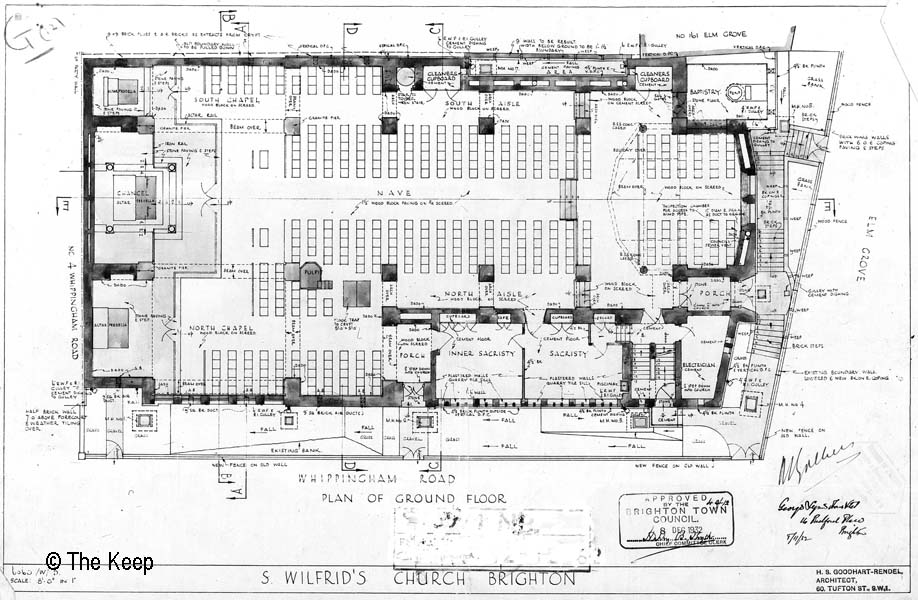
Ground plan for St Wilfrid Church dated 8 November 1932. Keep plan ref: DB/D/134/9139
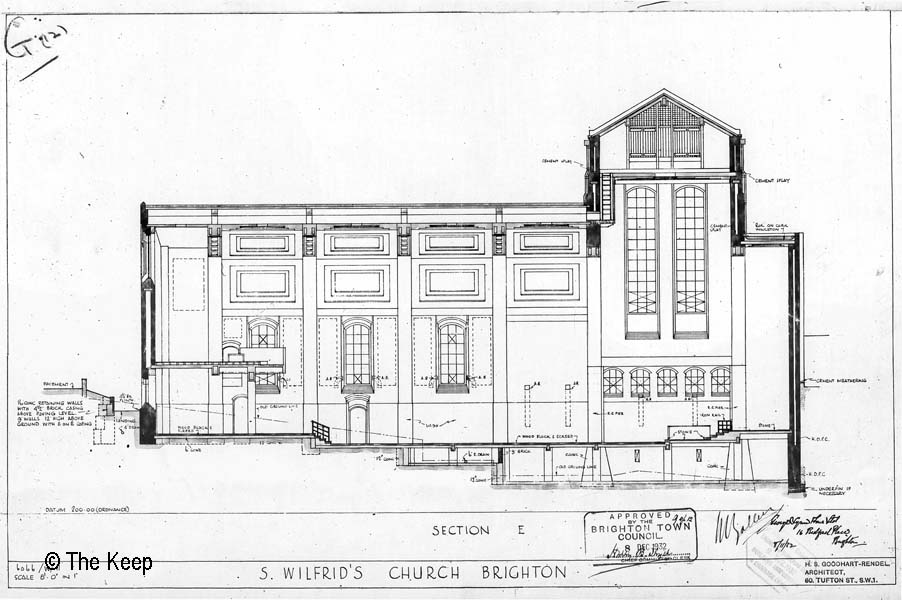
Elevation drawing for St Wilfrid Church dated 8 November 1932. Keep plan ref: DB/D/134/9139
St Wilfrid’s was consecrated on 25 November 1933 by George Bell, (Bishop of Chichester from June 1929 to October 1958).
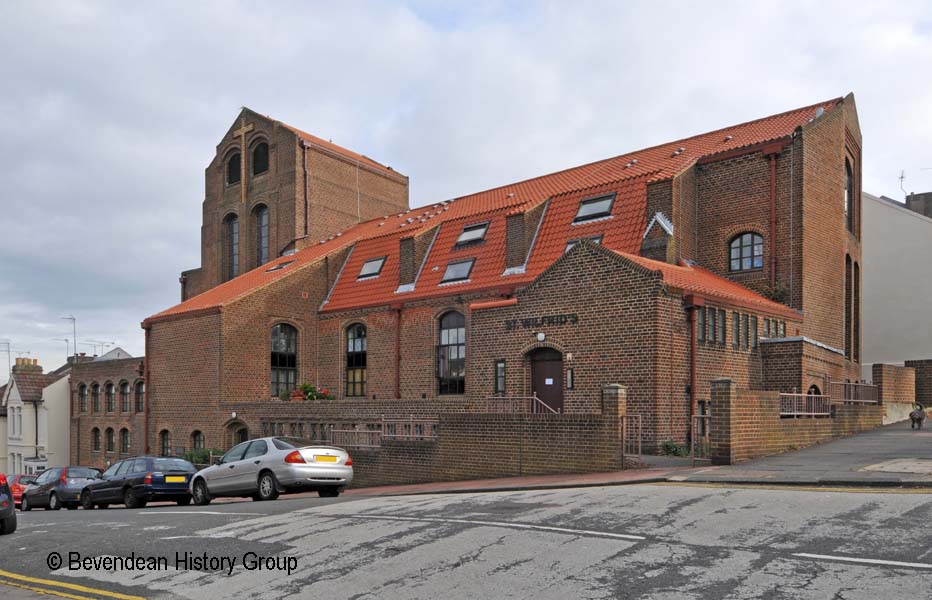
St Wilfrid’s Church viewed from the corner of Whippingham Road and Elm Grove in October 2018. Ref: BHG 2010-10-18
This was the first of the churches to be built under the auspices of the Bishop’s Call to Sussex.
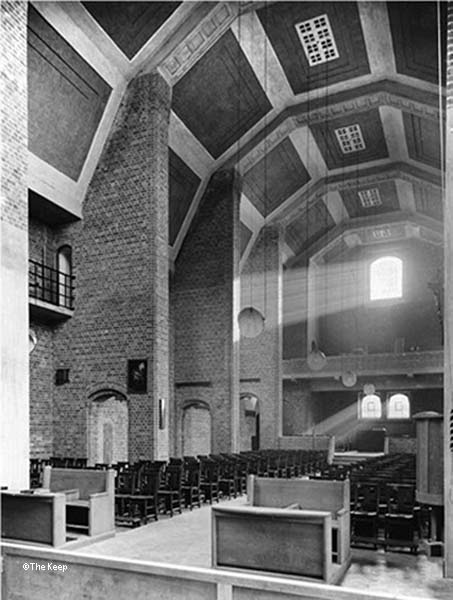
The interior of St Wilfrid’s Church. From the Keep Archives.
In 1940 St. Wilfrid’s Church in Elm Grove had the honour of being selected by the Bishop of Chichester (Dr. G. K. A. Bell) for the gift of a magnificent modern wall painting by the famous artist, Hans Feibusch.
Mr Feibusch, who was of German birth, became a naturalised Englishman in the 1930s was anxious to offer some gift to the country where he had found freedom; he got into touch with Sir Kenneth Clark, director of the National Gallery, and undertook to present a wall painting to a modern church.
Sir Kenneth consulted the Bishop of Chichester, who naturally thought of St Wilfrid's, Brighton, as one of the finest examples of modern church building. So, for the best part of two months, Mr Feibusch came to Brighton and spent his time giving the church a wall painting worthy of its architectural beauty and of modern art.
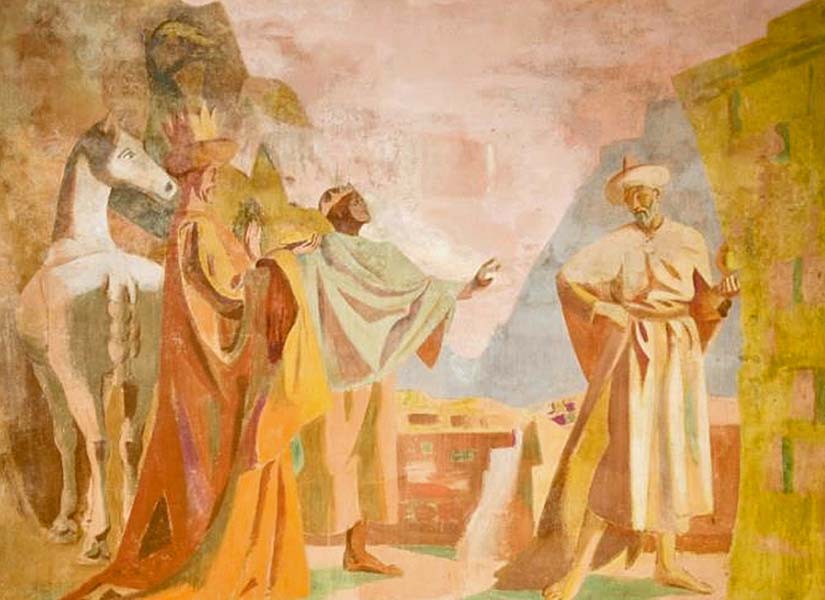
Painting of the Magi on the wall of St Wilfrid's Church by Hans Feibusch.
On 28 June 1971 the Rev. Derek Harold Cordell who was the Vicar of Coldean from 1963 to 1969 was appointed as the vicar of St. Wilfrid’s. Father Derek had recently returned from Bucharest where he was Anglican Chaplain to the British Communities in Romania, Bulgaria and Yugoslavia.
Structural problems and the discovery of asbestos in the ceiling put pressure on a dwindling congregation and in 1980 the church was declared redundant. When the Church Commissioners announced their intention to demolish the building, St Wilfrid's Church was granted Grade II listed status by English Heritage on 14 January 1981 and a public inquiry was held.
The threat of demolition was lifted, and the building was stripped internally and converted into 24 flats for elderly people. This meant dividing the interior; though outside only skylights in the aisle roofs reveal the change. Inside, the space under the tower has been left open and so has the north aisle.
Photographs and Plans for St Wilfrid’s Church
The Years Between 1901 and 1961
St Wilfrid Church - RIBA Articles
Tightly packed terraced housing was provided on the northern and southern slopes of the hill between the 1860s and 1900, and the area became very densely populated.
To begin with Anglican services were held in a series of rented rooms and halls in the area. As the congregation grew a temporary church built of tin was constructed on the site of the present church, at the junction of Elm Grove and Whippingham Road.

The Iron Church viewed from Elm Grove. Keep Ref: BHBox7/51
The iron church was inaugurated on 25 August 1901. A year earlier, the area had been designated a district within the Parish of Brighton. The building plans are dated 20 June 1901 and the service registers begin in 1901.
The church was dedicated in 1902 by the Bishop of Chichester Ernest Wilberforce.
By 1915 St Wilfrid's was listed as a chapel of ease to the parish church of St Peter.
The district of St Wilfrid was created from the parish of Brighton St Luke by an Order in Council of 21 April 1922. This brought an extra 2,000 people within its parish boundaries, and a permanent church was required.

Interior of the St Wilfrid’s Church. Keep Ref: BHBox7/51
The tin church was enlarged in 1904-05 when a two-storey extension was built at the northern end of the building. The original building is darker than the extension on the plans.

Keep Plan Ref: DB/D/7/6040
In the Brighton and Hove Herald in October 1932 the church was described as “The Cabbage Patch Church” or the “The Tin Kettle Church” quaint names given to St. Wilfrid’s church, Elm Grove, at a bazaar opened in the Mission Room to raise funds for a new church.
The Dean of Chichester opened the Bazaar and made the following observations.
“Both names were relevant for the people of St. Wilfrid, as they had a tin church in what was once a policeman’s cabbage patch.”
“The plot of land was bought 30 years ago with money from the Diocesan Bishops Fund.”
The Dean of Chichester was the Vicar of Brighton at the time and let the land for the magnificent sum of 30 shillings a year or so to a policeman, who made a very fine market garden out of it.
The Dean continued, “When the trams came up Elm Grove and the people of Brighton found that they could get up the hill for a penny they began to live up there. This was when the present tin church was put up and planning a permanent church has taken too long.”
“This place is the scandal of the Diocese, because there are 10,000 people here, and this is all they have to worship in. There is no other place with such spiritual destitution throughout the length and breadth of the County.”
Until 1922, St. Wilfrid’s was under the care of such devoted priests -in-charge as the Rev. C. H. Martin, now Rector of Blendworth, Hants; The Rev. T. J. James, now Prebendary of Heathfield and Vicar of Anne’s, Brighton; and the Rev. P. H. Pemberton, who became the first Vicar when the district became an independent parish in 1922.
On Mr Pemberton’s preferment to the Vicarage of All Souls’, Hastings, he was succeeded by the present Vicar (the Rev. W. A. E. Westall) whose energetic and self-sacrificing labours explain much of the “liveness” which characterises the Church life of the parish today”.
By 1932, £15,000 had been raised by the parishioners and from other sources, and services were held in the nearby parish hall (built in 1927) while the new church was built after the demolition of the tin church.

The foundation stone for the new church was laid on 3 December 1932 by Mary Moore the daughter of Bishop Winfrid Oldfield Burrows who was the Bishop of Chichester from 1919 to 1929. Ref: BHG 2024-06-30.
The new church – built by Messrs’ G. Lynn and Sons from the design of Mr. H. S. Goodhart-Rendel, F.R.I.B.A. – will be a memorial to Bishop Winfred Burrows (Bishop of Chichester from 1919 to 1929).

Ground plan for St Wilfrid Church dated 8 November 1932. Keep plan ref: DB/D/134/9139

Elevation drawing for St Wilfrid Church dated 8 November 1932. Keep plan ref: DB/D/134/9139
St Wilfrid’s was consecrated on 25 November 1933 by George Bell, (Bishop of Chichester from June 1929 to October 1958).

St Wilfrid’s Church viewed from the corner of Whippingham Road and Elm Grove in October 2018. Ref: BHG 2010-10-18
This was the first of the churches to be built under the auspices of the Bishop’s Call to Sussex.

In 1940 St. Wilfrid’s Church in Elm Grove had the honour of being selected by the Bishop of Chichester (Dr. G. K. A. Bell) for the gift of a magnificent modern wall painting by the famous artist, Hans Feibusch.
Mr Feibusch, who was of German birth, became a naturalised Englishman in the 1930s was anxious to offer some gift to the country where he had found freedom; he got into touch with Sir Kenneth Clark, director of the National Gallery, and undertook to present a wall painting to a modern church.
Sir Kenneth consulted the Bishop of Chichester, who naturally thought of St Wilfrid's, Brighton, as one of the finest examples of modern church building. So, for the best part of two months, Mr Feibusch came to Brighton and spent his time giving the church a wall painting worthy of its architectural beauty and of modern art.

Painting of the Magi on the wall of St Wilfrid's Church by Hans Feibusch.
On 28 June 1971 the Rev. Derek Harold Cordell who was the Vicar of Coldean from 1963 to 1969 was appointed as the vicar of St. Wilfrid’s. Father Derek had recently returned from Bucharest where he was Anglican Chaplain to the British Communities in Romania, Bulgaria and Yugoslavia.
Structural problems and the discovery of asbestos in the ceiling put pressure on a dwindling congregation and in 1980 the church was declared redundant. When the Church Commissioners announced their intention to demolish the building, St Wilfrid's Church was granted Grade II listed status by English Heritage on 14 January 1981 and a public inquiry was held.
The threat of demolition was lifted, and the building was stripped internally and converted into 24 flats for elderly people. This meant dividing the interior; though outside only skylights in the aisle roofs reveal the change. Inside, the space under the tower has been left open and so has the north aisle.
Photographs and Plans for St Wilfrid’s Church
The Years Between 1901 and 1961
St Wilfrid Church - RIBA Articles
